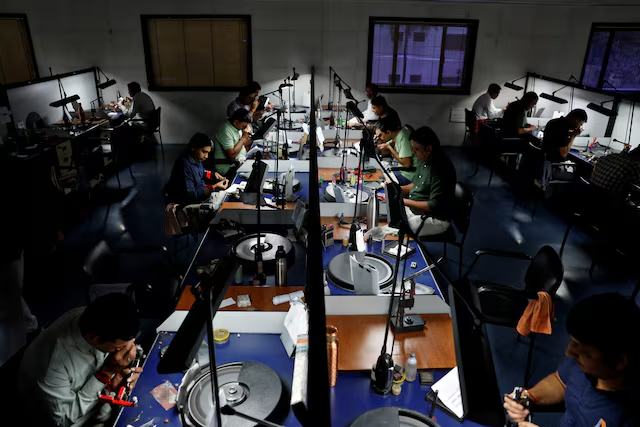To avoid the rise in US tariffs, tens of thousands of businesses seek new markets in Asia, Africa, and Europe. Shipments were pre-loaded by exporters ahead of the tariff hike deadline. The Indian government encourages businesses to investigate alternative markets rather than announcing support. About 2.2% of India’s GDP comes from exports to the United States. MUMBAI, Aug. 28 (Reuters) – A 50 percent tariff on exports to the United States went into effect on Wednesday, putting pressure on tens of thousands of small businesses in India to find new customers in markets in Europe, Africa, and Asia. Firms also front-loaded shipments earlier in August ahead of the August 27 deadline, sending out existing orders before tariffs were doubled from the 25% import tax imposed by U.S. In July, President Donald Trump. The Reuters Tariff Watch newsletter is your daily source for the most recent information on tariffs and global trade. Join him, Over 50,000 exporters among India’s nearly 60 million small enterprises, spanning sectors including textiles, jewelry and chemicals, face the tariff spike but the government has yet to announce any financial or credit support for those affected.
It has instead urged exporters to find alternative markets.
57% of export-oriented businesses surveyed by India SME Forum, a lobby group representing nearly 100,000 small businesses, were interested in rerouting shipments or value-added transshipments to countries in the Gulf, Latin America, Africa, and Britain. The point would be to identify markets where shipped products could be modified or re-manufactured to obtain a new “country of origin” tag and then export on to the U.S. market.
Another 27% were reviving business with buyers outside of the United States, and 16% were considering outsourcing parts of orders to businesses in other countries to keep those customers. “It seems like a lot of the time we try to actually sell to the United States because we get better pricing there,” we are hearing. “However, there are a lot of other markets, and those markets will now come into focus,” Vinod Kumar, president of the India SME Forum, stated. He stated, “So every supplier, whether medium, small, or large, is now reexamining the questions they received earlier, which they have not attended to because they had a better offer (in U.S. markets).” India’s economy, the fifth largest in the world, is dominated by small and medium-sized businesses, which account for approximately one third of GDP and 45% of all exports. Nvidia’s sales set a fresh record on Wednesday as the world’s most viable public company continues to capitalise on strong demand for AI.
FRONT-LOADING TO SOFTEN TARIFF HIT
To cushion the blow from Trump’s burgeoning tariff blitz, Indian exporters also front-loaded orders to the U.S. in August.
“We shipped near double our monthly volumes in August and even diverted some orders from European clients to the U.S.,” said Sanket Gandhi, director at Ahmedabad-based Pheromone Chemicals, which supplies speciality chemicals used in fragrances to U.S. customers including Procter and Gamble.
As a hedge against its U.S. business, Gandhi’s two companies, which have a combined turnover of 2.5 billion Indian rupees, are also negotiating with clients in Europe, Russia, and Africa, remaining hopeful of a resolution to the tariff dispute with the Trump administration. “By last week, we had shipped most of our shipments to the United States.” N stated, “We could take the hit between us and our customers at 25% tariffs and continue our business, but not at 50%.” Thirukkumaran, owner of Esstee Exports, a clothing manufacturer based in Tirupur. The HSBC Flash India PMI indicated that business activity expanded at the fastest rate in at least two decades this month, despite the fact that August export data has not yet been released. The table shows the sectors that get affected mainly from US tariffs on India and the total potential impact on trade numbers.
The total potential impact that US tariffs on India could have on trade numbers is shown in the table. Economists assert that over the course of a 12-month period, a decrease in India’s exports to the United States, which contribute 2.2% of the country’s GDP, could have an effect on economic growth of 0.6-0.8 percentage points. The central bank forecasts growth at 6.5% in the current fiscal year.
Banks that are significant lenders to small businesses would also suffer if export revenues significantly decreased. A banker at a state-owned lender stated that tariff-related uncertainties have caused credit to be “dulled in the last few weeks” for small and medium-sized businesses. “The atmosphere is one of caution… We are holding off on giving new loans to small and medium export-centric businesses that we have not lent to before,” the banker said.
Earlier this month, Reuters reported that the government intends to provide exporters and small businesses with credit guarantees to prevent banks from stopping new lending to these businesses. However, the government has yet to officially announce any relief. As of June 2025, bank loans to small and medium-sized businesses totaled 12.3 trillion rupees, or about 7% of all loans issued by Indian banks. ($1 = 87.5060 Indian rupees)
India’s small businesses scramble to cushion blow from Trump’s 50% tariffs




